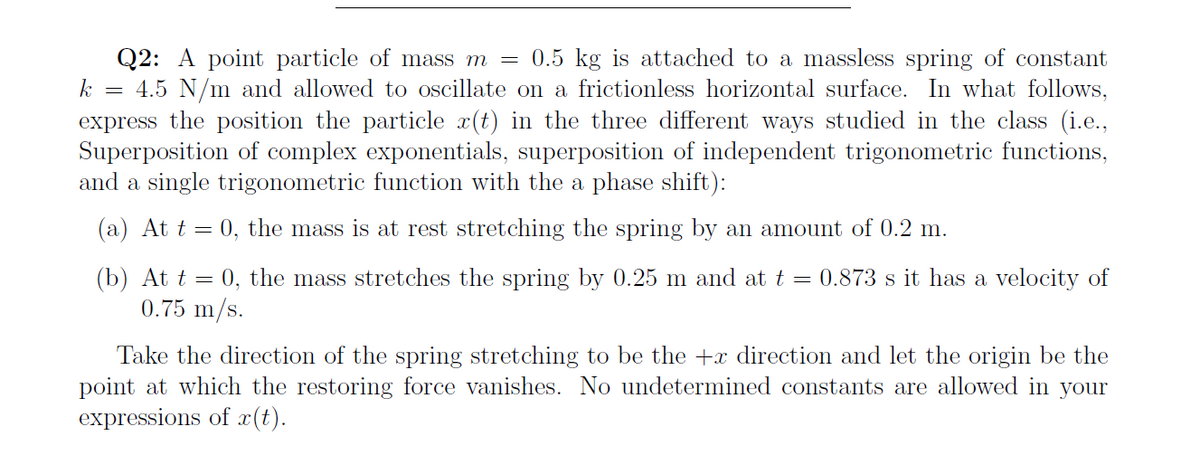Q2: A point particle of mass m = 0.5 kg is attached to a massless spring of constant k = 4.5 N/m and allowed to oscillate on a frictionless horizontal surface. In what follows, express the position the particle x(t) in the three different ways studied in the class (i.e., Superposition of complex exponentials, superposition of independent trigonometric functions, and a single trigonometric function with the a phase shift): (a) At t = 0, the mass is at rest stretching the spring by an amount of 0.2 m. (b) At t = 0, the mass stretches the spring by 0.25 m and at t = 0.873 s it has a velocity of 0.75 m/s. Take the direction of the spring stretching to be the +x direction and let the origin be the point at which the restoring force vanishes. No undetermined constants are allowed in your expressions of x(t).
Q2: A point particle of mass m = 0.5 kg is attached to a massless spring of constant k = 4.5 N/m and allowed to oscillate on a frictionless horizontal surface. In what follows, express the position the particle x(t) in the three different ways studied in the class (i.e., Superposition of complex exponentials, superposition of independent trigonometric functions, and a single trigonometric function with the a phase shift): (a) At t = 0, the mass is at rest stretching the spring by an amount of 0.2 m. (b) At t = 0, the mass stretches the spring by 0.25 m and at t = 0.873 s it has a velocity of 0.75 m/s. Take the direction of the spring stretching to be the +x direction and let the origin be the point at which the restoring force vanishes. No undetermined constants are allowed in your expressions of x(t).
Classical Dynamics of Particles and Systems
5th Edition
ISBN:9780534408961
Author:Stephen T. Thornton, Jerry B. Marion
Publisher:Stephen T. Thornton, Jerry B. Marion
Chapter12: Coupled Oscillations
Section: Chapter Questions
Problem 12.16P
Related questions
Question

Transcribed Image Text:Q2: A point particle of mass m = 0.5 kg is attached to a massless spring of constant
= 4.5 N/m and allowed to oscillate on a frictionless horizontal surface. In what follows,
express the position the particle x(t) in the three different ways studied in the class (i.e.,
Superposition of complex exponentials, superposition of independent trigonometric functions,
and a single trigonometric function with the a phase shift):
k
(a) At t =
0, the mass is at rest stretching the spring by an amount of 0.2 m.
(b) At t = 0, the mass stretches the spring by 0.25 m and at t = 0.873 s it has a velocity of
0.75 m/s.
Take the direction of the spring stretching to be the +x direction and let the origin be the
point at which the restoring force vanishes. No undetermined constants are allowed in your
expressions of c(t).
Expert Solution
This question has been solved!
Explore an expertly crafted, step-by-step solution for a thorough understanding of key concepts.
Step by step
Solved in 5 steps with 5 images

Recommended textbooks for you

Classical Dynamics of Particles and Systems
Physics
ISBN:
9780534408961
Author:
Stephen T. Thornton, Jerry B. Marion
Publisher:
Cengage Learning

Physics for Scientists and Engineers: Foundations…
Physics
ISBN:
9781133939146
Author:
Katz, Debora M.
Publisher:
Cengage Learning

Modern Physics
Physics
ISBN:
9781111794378
Author:
Raymond A. Serway, Clement J. Moses, Curt A. Moyer
Publisher:
Cengage Learning

Classical Dynamics of Particles and Systems
Physics
ISBN:
9780534408961
Author:
Stephen T. Thornton, Jerry B. Marion
Publisher:
Cengage Learning

Physics for Scientists and Engineers: Foundations…
Physics
ISBN:
9781133939146
Author:
Katz, Debora M.
Publisher:
Cengage Learning

Modern Physics
Physics
ISBN:
9781111794378
Author:
Raymond A. Serway, Clement J. Moses, Curt A. Moyer
Publisher:
Cengage Learning